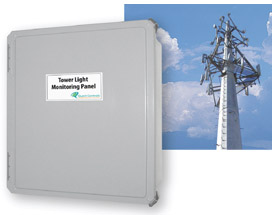
The Quest Tower Light Monitoring Panel interfaces directly with the TELSEC® Controller to provide constant monitoring of tower lights. Designed to provide safe, reliable and long life monitoring and alarming for most tower applications. All models include a NEMA 4 outdoor enclosure and a calibrated light level sensor for monitoring day/night switching.
Summary
The Quest Tower Light Monitoring Panel offers a cost- effective solution to the problem of maintaining FCC and FAA standards for monitoring and safety. In recent years, fines for violations have risen to the tens of thousands, and in some cases to the hundreds of thousands of dollars. These penalties apply not only to the tower owners, but also to those leasing tower space. Quest Tower light monitoring continually senses the status of all aspects associated with proper beacon and flasher operation and sidelight or obstruction light performance.
The monitor is in a waterproof housing that allows placement inside, outside or on the tower itself. Every system comes with a light level sensor to ensure proper monitoring of the lighting control circuits. When a tower light fails, the FCC requires that you notify the FAA within 30 minutes (or risk being fined). The Quest monitoring solution will help meet this requirement by constantly monitoring the tower lights and notifying you immediately in the event of a failure. Be safe and secure and able to sleep at night knowing that the Quest Tower Light Monitoring System will prevent a system failure from making you tomorrow’s headline.
Features
- Meets or exceeds FAA and FCC tower light monitoring requirements.
- Immediate notification in the event of a failure via e-mail, SNMP Traps or dialup.
- Modular design allows customization for nearly any application.
- Mount the panel inside, outside or on the tower.
- Uses industry standard, non-proprietary components.
- Can be easily adapted to all existing structures.
- View the status of deployed equipment through the built-in Web Browser in the TELSEC® Controller.
- All alarms and events are stored for historical reports.
- Redundant alarm contacts are available.

